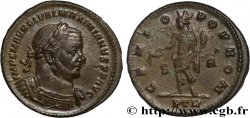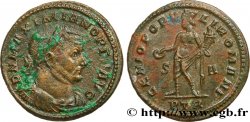v18_0653 - MAXIMIANUS HERCULIUS Follis ou nummus
MONNAIES 18 (2003)
Starting price : 100.00 €
Estimate : 150.00 €
Realised price : 100.00 €
Number of bids : 1
Maximum bid : 110.00 €
Starting price : 100.00 €
Estimate : 150.00 €
Realised price : 100.00 €
Number of bids : 1
Maximum bid : 110.00 €
Type : Follis ou nummus
Date: été 307
Mint name / Town : Roma
Metal : copper
Diameter : 25,5 mm
Orientation dies : 6 h.
Weight : 6,04 g.
Rarity : R1
Officine: 2e
Emission: 1re
Coments on the condition:
Magnifique portrait, taillé à la serpe. Jolie patine marron glacé avec des reflets métalliques. Très joli revers
Catalogue references :
Obverse
Obverse legend : IMP C MAXIMIANVS P F AVG.
Obverse description : Tête laurée de Maximien Hercule à droite (O*).
Obverse translation : “Imperator Cæsar Maximianus Pius Felix Augustus”, (L'empereur césar Maximien pieux et heureux auguste).
Reverse
Reverse legend : CONSERVATO-RES - VRB SVAE// R*S.
Reverse description : Temple hexastyle de Rome posé sur trois marches avec un fronton triangulaire décoré ; au centre statue de Rome debout à gauche, tenant un globe de la main droite et un sceptre long de la main gauche.
Reverse translation : “Conservatores Urbis Suæ”, (Les protecteurs de leur ville).
Commentary
La légende a été répartie autour du portrait qui occupe la plus grande partie du flan.








 Report a mistake
Report a mistake Print the page
Print the page Share my selection
Share my selection Ask a question
Ask a question Consign / sell
Consign / sell
 Full data
Full data



